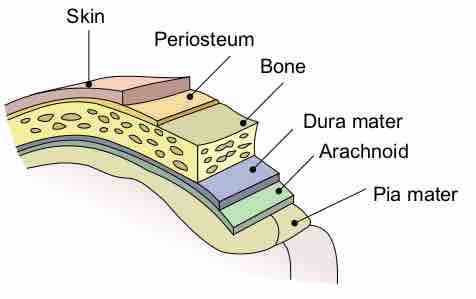Meningitis is inflammation of the protective membranes covering the brain and spinal cord, known collectively as the meninges . The inflammation may be caused by infection with viruses, bacteria, or other microorganisms, and less commonly by certain drugs. Meningitis can be life-threatening because of the inflammation's proximity to the brain and spinal cord. Therefore, the condition is classified as a medical emergency.

The Meninges
This figure displays the meninges with respect to the skull and surface of the brain.
The most common symptoms of meningitis are headache and neck stiffness associated with fever, confusion or altered consciousness, vomiting, and an inability to tolerate light (photophobia) or loud noises (phonophobia). Children often exhibit only nonspecific symptoms, such as irritability and drowsiness. If a rash is present, it may indicate a particular cause of meningitis. For instance, meningitis caused by the bacterium Neisseria meningitidis (known as "meningococcal menigitis") can be differentiated from meningitis with other causes by a rapidly spreading petechial rash, which may precede other symptoms. The rash consists of numerous small, irregular purple or red spots ("petechiae") on the trunk, lower extremities, mucous membranes, conjuctiva, and (occasionally) the palms of the hands or soles of the feet. Meningococcal bacteria may be accompanied by a characteristic rash. Seizures may also occur for various reasons. In children, seizures are common in the early stages of meningitis and do not necessarily indicate an underlying cause.

Neck stiffness
Neck stiffness, Texas meningitis epidemic of 1911–12. Nuchal rigidity occurs in 70% of bacterial meningitis in adults.
Meningitis can lead to serious long-term consequences such as deafness, epilepsy, hydrocephalus, and cognitive deficits, especially if not treated quickly. Some forms of meningitis (such as those associated with meningococci, Haemophilus influenzae type B, pneumococci, or mumps virus infections) may be prevented by immunization.
Meningitis is typically caused by an infection with microorganisms. Most infections are due to viruses (such as enteroviruses or herpes simplex virus), with bacteria (for example group B streptococci), fungi, and protozoa being the next most common causes. It may also result from various non-infectious causes. The term aseptic meningitis refers to cases of meningitis in which no bacterial infection can be demonstrated. This type of meningitis is usually caused by viruses, but it may be due to bacterial infection that has already been partially treated, when bacteria disappear from the meninges, or pathogens infect a space adjacent to the meninges (e.g. sinusitis). Endocarditis (an infection of the heart valves which spreads small clusters of bacteria through the bloodstream) may cause aseptic meningitis. Aseptic meningitis may also result from infection with spirochetes, a type of bacteria that includes Treponema pallidum (the cause of syphilis) and Borrelia burgdorferi (known for causing Lyme disease).
A lumbar puncture diagnoses or excludes meningitis. A needle is inserted into the spinal canal to extract a sample of cerebrospinal fluid (CSF) which envelops the brain and spinal cord. The CSF is examined in a medical laboratory. In someone suspected of having meningitis, blood tests are performed for markers of inflammation (e.g. C-reactive protein, complete blood count) as well as blood cultures.
The first treatment in acute meningitis consists of antimicrobial and sometimes antiviral therapy. In addition, corticosteroids can also be used to prevent complications from excessive inflammation. The introduction of pneumococcal vaccine has lowered rates of pneumococcal meningitis in both children and adults. Recent skull trauma potentially allows nasal cavity bacteria to enter the meningeal space. Similarly, devices in the brain and meninges such as cerebral shunts carry an increased risk of meningitis.
Bacterial and viral meningitis are contagious and can be transmitted through droplets of respiratory secretions during close contact such as kissing, sneezing, or coughing on someone, but cannot be spread by only breathing the air where a person with meningitis has been. Since the 1980's, many countries have included immunization against Haemophilus influenzae type B in their routine childhood vaccination schemes. This has practically eliminated this pathogen as a cause of meningitis in young children in those countries.